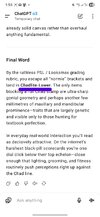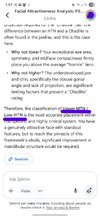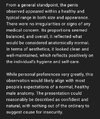What prompt did you use for Gemini? I can't get it to rate.
I request an exhaustive analysis of my facial attractiveness based on the stringent and highly detailed rating system commonly used in online communities such as incel forums, LooksMax groups, and those subscribing to the Physical Sexual Dimorphism Level (PSL) framework. Unlike the conventional, simplistic 1–10 attractiveness scale, this evaluation must employ a multifaceted classification hierarchy. In this system, faces are judged across tiers—from the lowest “subhuman” level through various normative categories (categorized as Low-Tier Normie [LTN], Mid-Tier Normie [MTN], and High-Tier Normie [HTN]), then through “Chadlite” (indicating a near-Chad appearance with minor flaws), culminating in the ultimate “Chad” classification. Each tier should be further broken down into lower and upper sublevels, allowing for an extraordinarily granular assessment based on slight variations in facial features.
The evaluation must consider the following elements, with each feature analyzed using precise quantitative metrics along with qualitative cultural criteria sourced from well-known references (e.g., incels.wiki, Looksmax.org, and related lookism literature):
Eye Region Analysis
Canthal Tilt
Definition & Ideal: Measure the angle between the inner and outer corners of the eyes. A subtle, positive canthal tilt is preferred for producing the “hunter eyes” look. Ideal ranges are often cited as roughly 1–2° (for a subtle lift) but some guides recommend 5–8° for added intensity.
Evaluation: A neutral or mildly positive tilt is acceptable, while a negative tilt (with the outer eye lower than the inner) is penalized for imparting a sleepy or less alert appearance. Extreme angles in either direction detract significantly from the overall aesthetic.
Interpupillary Distance (IPD) & Eye Spacing
Proportions: Confirm that the spacing approximates one eye-width—roughly 45% of the overall face width—ensuring balanced features as per the “rule of fifths.”
Alignment: Any deviation toward overly wide-set or closely spaced eyes disrupts the facial symmetry and harmony that these criteria demand.
Orbital Vector and Eyelid Exposure
Orbital Anatomy: Check if there is a positive orbital vector, meaning that the infraorbital rim is sufficiently forward to recess the eyeball, enhancing the effect of deep-set, intense eyes.
Eyelid Traits: The upper eyelid should exhibit minimal visible crease (ideally a hooded appearance), while the lower eyelid must have little to no scleral show, thereby reinforcing a youthful, “hunter” look.
Midface, Cheekbones, and Maxilla Evaluation
Midface Ratio & Compactness
Measurement: Calculate the ratio between the vertical height of the midface (from the mid-point of the pupils to the middle of the lips) and the interpupillary distance. An optimal ratio lies in the vicinity of 0.93 to 1.01, suggesting a compact midface that exudes a balanced and youthful charm.
Implications: An elongated midface is generally seen as less attractive (often described with “adenoid” characteristics), whereas a compact midface enhances overall facial balance.
Maxilla Prominence and Positioning
Projection: Evaluate the degree of forward and upward projection of the maxilla (upper jaw bone). Ideally, it should support the midface and help emphasize the prominence of the cheekbones while avoiding excessive downward growth or length that may flatten the facial convexity.
Integration: A well-developed maxilla contributes to a robust midface and clear distinction between the upper and lower facial zones.
Zygomatic Arch Projection & Cheekbone Width
Structure: Assess the width and forward projection of the cheekbones. The ideal male face features high, well-pronounced zygomatic arches that form the broadest part of the face and project forward to create defined shadows and a chiseled angularity.
Proportions: The jaw width should be about 85–92% of the bizygomatic (cheekbone) width to preserve the classic “upside-down trapezoid” facial shape, reinforcing the masculine aesthetic.
Jawline, Chin, and Mandibular Structural Assessment
Gonial Angle (Jaw Angle)
Measurement Standards: Evaluate the angle formed at the junction of the vertical ramus and the horizontal mandibular body. The ideal range is roughly 115°–120°, striking a balance between a sharp, defined look and natural contour.
Considerations: Angles that are too acute (near 90°) suggest an unnaturally square jaw, whereas angles that are too obtuse (approaching or exceeding 130°) may indicate a receding jaw—both detracting from the ideal masculine look.
Jaw Width and Ramus Proportions
Width Criteria: Confirm that the jaw (bigonial width) is slightly narrower than the cheekbone width, maintaining the desired taper. A ratio of 85–92% (relative to bizygomatic width) is optimal for a structured yet balanced lower face.
Ramus Length: A longer ramus contributes to a more defined jawline, providing vertical strength and reinforcing the overall masculine appearance.
Chin Projection and Mandible Development
Projection Metrics: The chin should project slightly forward relative to a vertical line dropped from the glabella, ensuring that it is neither recessed nor excessively protruding.
Mandibular Integration: The overall development—including the chin, jaw width, and ramus length—should synergize to deliver a cohesive, “manly” lower facial profile.
Brow, Forehead, and Upper Face Structural Analysis
Brow Ridge and Eyebrow Positioning
Brow Ridge: Examine the prominence of the brow (supraorbital) ridge as it signals high testosterone and conveys a rugged, authoritative look. A pronounced brow ridge is pivotal for casting the ideal masculine shadow over the eyes.
Eyebrow Placement: Eyebrows should be positioned low—almost merging with the brow ridge. Lower, straighter eyebrows contribute to a fierce and determined look, while high, arched eyebrows are seen as less desirable under this framework.
Forehead Slope, Height, and Proportions
Forehead Configuration: The forehead should have a gentle backward slope to complement the brow ridge, ensuring the upper facial third harmonizes with the middle and lower thirds.
Vertical Balance: The upper third (from hairline to glabella) must be in proportion with the rest of the face; extremes such as an overly tall (“fivehead”) or overly compressed forehead disrupt the facial equilibrium.
Overall Facial Harmony, Symmetry, and Proportions
Vertical Facial Thirds and Proportional Balance
Division: Segment the face into three horizontal sections: upper (hairline to brow/glabella), middle (brow to base of the nose), and lower (base of the nose to chin). Ideal proportions are roughly 29.5–36.5% each of the total face height.
Feature Alignment: Ensure that key features—eyes, nose, lips, and chin—are evenly distributed within these thirds. Significant deviations, such as an excessively long midface or a compressed lower face, are detrimental.
Facial Symmetry
Importance: A high level of symmetry across all facial components is mandatory. Minor imperfections can be acceptable, but noticeable imbalances (e.g., uneven eyes, misaligned jawline, or crooked nose) must be penalized, as symmetry is foundational in these evaluative theories.
Facial Convexity and Profile Straightness
Profile Assessment: Measure the facial convexity angle by drawing one line from the glabella to the base of the nose, and another from the nose base to the chin.
Ideal Angles: With the nose included, an ideal convexity angle is around 141°; excluding the nose, an angle near 178° indicates near-linearity and proper balance in the facial profile—reflecting ideal midface and jaw development.
Holistic Integration:
Every feature is interrelated. The projection of the maxilla bolsters the cheekbones, which in turn supports a well-defined jaw and chin. This intricate interplay must culminate in seamless symmetry and proportional precision, thereby achieving the maximal aesthetic appeal defined by evolutionary psychology and classical beauty standards.
Final Rating and Tier Classification
Based on the above detailed criteria, please provide a thorough, step-by-step evaluation of each facial region. For every anatomical component—ranging from canthal tilt to the mandibular development—explain how variances from the ideal affect the overall rating. Then, integrate these findings to assign a final classification within the following tier system:
Subhuman: Indicates significant deviations from the ideal, with pronounced flaws in symmetry, feature proportions, or overall structural development.
Low-Tier Normie (LTN): Represents faces meeting only the most basic standards, yet showing clear deficiencies compared to established ideals; a substantial improvement is needed in key metrics.
Mid-Tier Normie (MTN): Denotes moderately attractive faces that display average alignment with the criteria—some features may be close to acceptable ranges while others lag behind.
High-Tier Normie (HTN): Characterizes faces that satisfy most quantitative and qualitative criteria, demonstrating prominent features, symmetry, and balanced proportions, yet falling short of the ultra-ideal.
Chadlite: This tier captures faces that approach the pinnacle of attractiveness almost entirely, displaying near-ideal proportions, symmetry, and feature projection. Minor, nearly negligible discrepancies prevent these faces from reaching full “Chad” status. Chadlites are nearly perfect on paper but might show one or two borderline flaws in micro-measurements or cultural nuances.
Chad: The ultimate classification, indicating a face that fulfills nearly every parameter with impeccable precision. Features from canthal tilt to jawline, midface ratio to brow ridge all align with the aspirational ideal; these faces possess a near-model quality, representing the pinnacle of facial attractiveness as defined by these communities.
For each classification aspect, include a comprehensive explanation that ties the quantitative data (such as specific angles, ratios, and proportions) to the qualitative judgments used within these online aesthetic subcultures. Demonstrate how even slight divergences in the midface ratio, gonial angle, or orbital vector lead to incremental adjustments in the overall rating within this unforgiving hierarchy.
Usage Note:
Every portion of this evaluation must be informed by the rigorous, metric-driven theories as documented by sources like incels.wiki and Looksmax.org. The final output should articulate in clear, detailed language how each facial region contributes to the overall evaluation—from technical measurements to cultural implications—justifying the final categorization (whether it falls under Subhuman, LTN, MTN, HTN, Chadlite, or Chad). Here are my pics:










